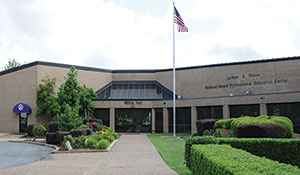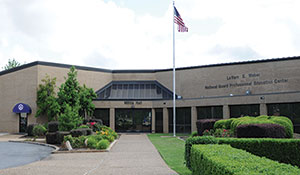
Reserve Component Aviation Update / By COL Mark W. Weiss: Rare is the commander that’s satisfied with his or her unit’s communications. Whether it’s the reception quality on a high-freq radio, the interactions between staff and subordinate commands, or the network connectivity, we’re always seeking “better comms.”
 Army National Guard Professional Education Center (PEC), Camp Robinson, AR. / U.S. ARMY NATIONAL GUARD PHOTOThe ARNG is no different – we’re always looking for better comms throughout the Guard’s Aviation Enterprise. I’ll report on two recent improvements.
Army National Guard Professional Education Center (PEC), Camp Robinson, AR. / U.S. ARMY NATIONAL GUARD PHOTOThe ARNG is no different – we’re always looking for better comms throughout the Guard’s Aviation Enterprise. I’ll report on two recent improvements.
Domestic Radios
One unique requirement of ARNG aircrews is that they be able to communicate effectively with civil authorities – police, firefighters, rescue personnel, and other first responders. A few years back, we discovered a gap in our CH-47 and UH-60 fleets, which arose when the Federal Communication Commission (FCC) established a single, emergency communication system/protocol (Project 25). After we obtained approval of an Operational Needs Statement to address this gap, the Guard began working with the CH-47 Program Manager to determine the material solution and obtain the necessary Air Worthiness Release (AWR). Ultimately, the Technisonic TDFM-9000 was selected for integration into the CH-47F, and fielding should be complete by the end of this fiscal year (one A-kit per aircraft, one B-kit per three aircraft). And while a material solution for the UH-60 is still being developed, it should be fielded by the beginning of FY17.
Readiness and Resources
Optimally training our units as they progress through the Army Force Generation (ARFORGEN) cycle is always a challenge, especially given the geographic dispersion of our Force and the primacy of State authority when units are in Title 32 status. So it’s imperative that our State Army Aviation Officers (SAAOs) and unit commanders communicate their readiness status and resource requirements to those with the resources. For the first time, we recently brought all of these folks together at the same time, at one place… Camp Robinson, Arkansas. Held at the Guard’s Professional Education Center (PEC), this initial (beta-test) “Readiness and Resources Review” brought together Forces Command Aviation, First Army Aviation, the 166th Aviation Brigade, the Guard’s Aviation and Safety Division, four (of the Guard’s 12) Aviation brigade commanders, and all of their supporting SAAOs to review the readiness statuses and identify resourcing requirements for these units. Ultimately, our States retain daily training management and oversight authority, but brigade commanders must reach across State lines to monitor and assist all subordinate units in their readiness progressions. This new venue was an eye-opener for all attendees, and we hope to expand this “better comms” next year, to include all 12 of the ARNG aviation brigades.
Before signing off, let me give a plug for the PEC. For those AC and USAR bubbas unfamiliar with the PEC, please consider it for your next professional workshop / conference / off-site meeting. The PEC has its own lodging, its own dining facility, and a wide range of business-rooms, loaded with the latest technology. And its staff is incredibly talented and responsive. Here’s the link: http://www.pec.ng.mil/Index/About.
Fly Safe; fly Guard.
COL Mark Weiss is the chief of the Army National Guard Aviation and Safety Division located in Arlington, VA.Army National Guard Professional Education Center (PEC), Camp Robinson, AR. / U.S. ARMY NATIONAL GUARD PHOTO










